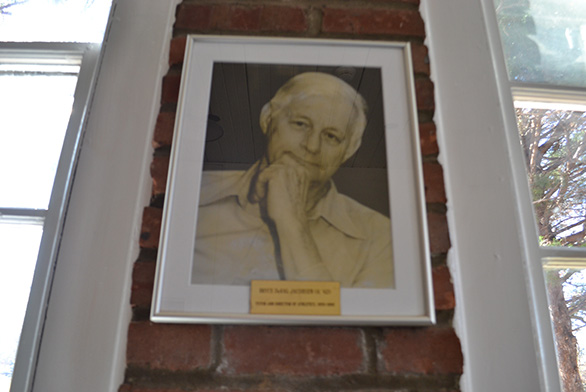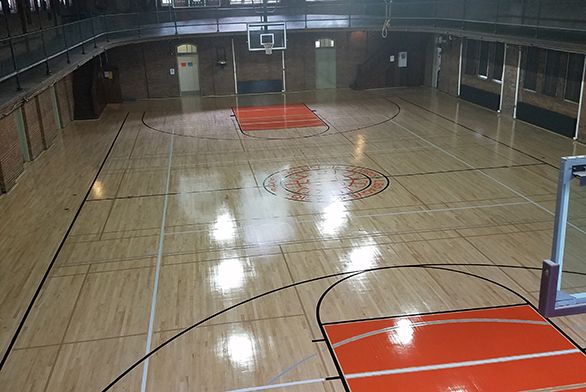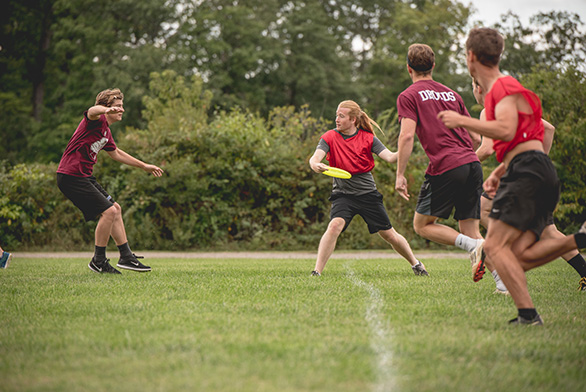A New Era in Athletics
December 2, 2016 | By Tim Pratt

When Bryce Jacobsen took over as athletic director of St. John’s College in Annapolis in 1958, interest in intramural sports was floundering.
A once-thriving intercollegiate athletic program had been eliminated in the late 1930s. And intramural sports, which struggled to attract students since World War II, continued to lack organization.
So in 1962, Jacobsen started a new form of intramural athletics that still exists today.
The goal was to provide a balance in talent among the teams, but also a sense of continuity. Novice athletes were encouraged to compete, just as they are now. And Jacobsen wanted to create a sense of pride and enthusiasm for each team.
More than 50 years later, his efforts have proven to be a success.
The athletic director started by selecting a group of captains, and using the entire student body as one pool, the captains drafted teams. Entering freshmen would be randomly divided into equal groups and allotted to each team. The teams would be assigned colors and adopt names. They were the Panzas, the Reds, the Greenwaves, the Guardians and the Spartans.
The following year, freshmen would be randomly assigned to the existing teams. Rising sophomores would go into an annual draft. Once drafted, the sophomores would stay on those teams until they graduated.
Mid-way through the first year of the new system, Jacobsen wrote: “There can be no doubt that this has been the best fall athletic program that we have had in the last five years, and probably for many more than five.”
Four women’s teams also formed: the Maenads, the Amazons, the Furies and the Nymphs.
Sports have changed over the years, depending on what was popular at the time, along with some of the team names.
The Maenads became the Daughters of Camilla; the Panzas became the Druids; the Reds became the Hustlers.
Legend has it that the Hustlers got their name because two of the team’s captains spent time playing billiards at a pool hall on Main Street.
Jacobsen also introduced “A” and “B” teams, giving participants a chance to compete against players of equal talent on other teams.
Team wins in each sport were tallied, and at the end of the year the team with the most wins became the overall champion. They are now immortalized on plaques in the gymnasium, along with the individual outstanding athletes.
The Present

Alum Jon Barone (A13) developed an interest in the history of athletics at the college while a student in 2012. That summer, he walked through Iglehart Gymnasium, read all of the plaques and compiled statistics of the winners since 1962.
But Barone also looked at the evolution of athletics at the college, from Jacobsen’s tenure through 1988 to Pickens’ term through 2012.
Jacobsen and Pickens oversaw many changes, from improvements to the gymnasium to variations in sports offerings.
Over the years, basketball popularity increased; volleyball was scaled back; softball participation waned and was replaced by handball. Soccer and flag football, meanwhile, were constants. Ultimate Frisbee exploded in popularity.
And Croquet grew into a community-wide event. In 2016, more than 7,000 people attended the annual match between St. John’s and the Naval Academy.
Crew, sailing and fencing also emerged over the years, giving St. John’s its intercollegiate sports back.
Trends
Intramural sports recently have increased in popularity. Athletics and Recreation Coordinator Chris Krueger (A07) estimates participation in all sports is up 10 percent this year.
Barone recently gathered updated intramural statistics though this spring. The results show some interesting trends:
The Hustlers are the winningest team in St. John’s history with 16 ½ wins, including a tie in 1976 with the Spartans. The team had a bit of a dynasty between 1967 and 1976, during which it won 7 ½ championships.
The Guardians and Greenwaves are tied at 12 wins each for second place. The Druids have seven wins and the Spartans have 6 ½.
Barone, a member of the Greenwaves, still lives in the area and comes back to campus regularly to play with his team. Alumni, tutors and other staff, who also are assigned to teams, are allowed to participate in intramural athletics.
“A lot of people who graduate move away from Annapolis, but still being a member of the team and still being able to come back and participate really fosters that sense of community,” Barone says.
Team allegiances remain strong years after graduation.

“We played together and developed great bonds on the playing field,” says former Athletic Director Leo Pickens, who graduated in 1978 and is a member of the Druids. “Even though you might think St. John’s intramurals is no big deal, we can still get together over a pint and tell a great story of a soccer game in a hurricane, when Chris Borden drove one in the back of the net to win the game in the pouring rain.”
Even Annapolis President Chris Nelson, a star athlete when he attended in the late 1960s, still feels a strong connection to the intramural program. He was drafted as a Druid, but was traded to the Spartans his sophomore year.
“I am, to this day, a Spartan,” he says with a smile.
Nelson says some of the best friendships he made at St. John’s were a result of the intramural program. His performances left an impression on those who competed with him or saw him play.
“I would put Chris Nelson on my all-star team,” Pickens says. “My all-time Johnnie all-star team.”
Jerry Januszewski, who attended the Graduate Institute in the 1990s, is another prominent athlete in St. John’s lore. One of the things he enjoyed most about intramurals was the fact that students who never played sports before could compete with students who were all-stars in high school. And it was done in a welcoming environment.
“It’s incredible to see people who never played a sport come out and play,” Januszewski says. “The amount of courage that takes is enormous. But every year, students do that.”
Catch up on Part 1 of the series: St. John’s: Unlikely Pioneers of Sport.

